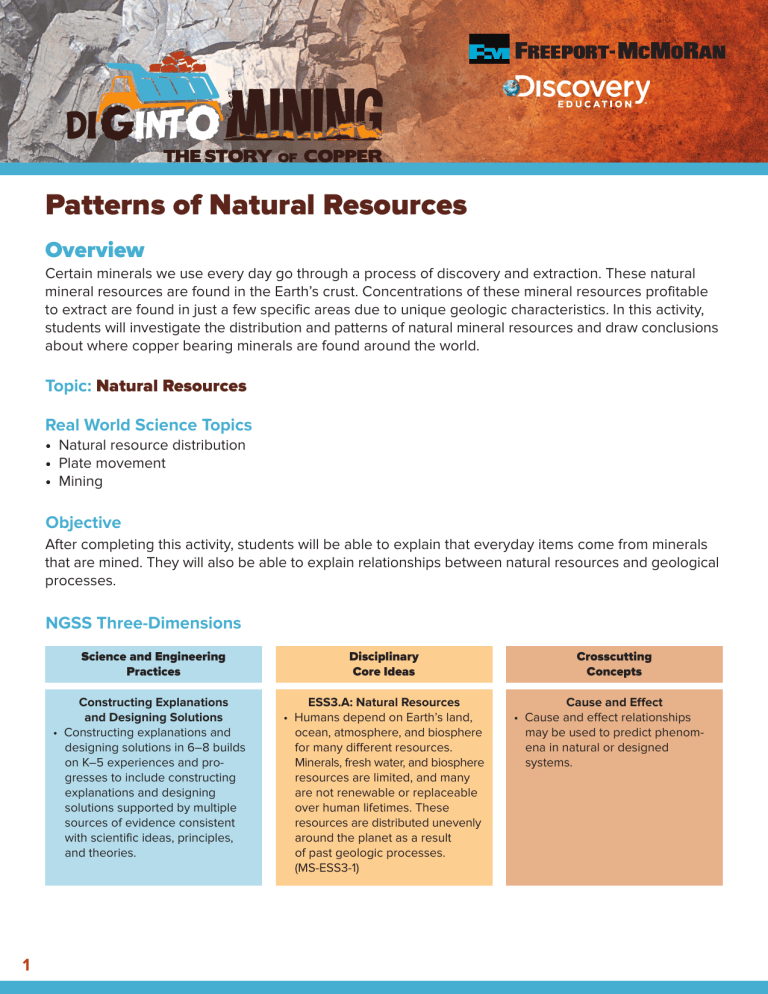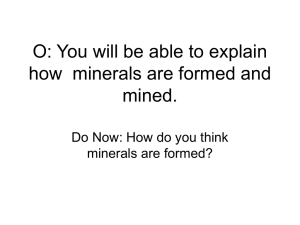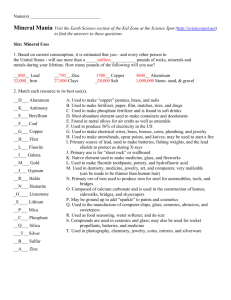Patterns of Natural Resources

1
Patterns of Natural Resources
Overview
Certain minerals we use every day go through a process of discovery and extraction. These natural mineral resources are found in the Earth’s crust. Concentrations of these mineral resources profitable to extract are found in just a few specific areas due to unique geologic characteristics. In this activity, students will investigate the distribution and patterns of natural mineral resources and draw conclusions about where copper bearing minerals are found around the world.
Topic: Natural Resources
Real World Science Topics
• Natural resource distribution
• Plate movement
• Mining
Objective
After completing this activity, students will be able to explain that everyday items come from minerals that are mined. They will also be able to explain relationships between natural resources and geological processes.
NGSS Three-Dimensions
Science and Engineering
Practices
Constructing Explanations and Designing Solutions
• Constructing explanations and designing solutions in 6–8 builds on K–5 experiences and progresses to include constructing explanations and designing solutions supported by multiple sources of evidence consistent with scientific ideas, principles, and theories.
Disciplinary
Core Ideas
ESS3.A: Natural Resources
• Humans depend on Earth’s land, ocean, atmosphere, and biosphere for many different resources.
Minerals, fresh water, and biosphere resources are limited, and many are not renewable or replaceable over human lifetimes. These resources are distributed unevenly around the planet as a result of past geologic processes.
(MS-ESS3-1)
Crosscutting
Concepts
Cause and Effect
• Cause and effect relationships may be used to predict phenomena in natural or designed systems.
2
Background Information
Where are natural resources located?
Natural resources are useful materials found on and beneath Earth’s surface. A variety of natural resources are used every day. Food and water are both natural resources. Other resources include soil, trees, and rocks and minerals.
Materials extracted from mineral resources important to modern technological societies are not uniformly distributed across the planet (e.g., oil in the Middle East, gold in Nevada). Most elements exist in Earth’s crust at concentrations too low to be mined, but in specific locations—where geological processes have concentrated them—extraction is economically viable.
Concentrations of mineral resources profitable to extract are called mineral deposits. Mineral deposits form when a special set of circumstances happen on or beneath the Earth’s surface.
How are natural mineral resources extracted?
Mining is one way to extract minerals from the Earth. Once the minerals are mined, they usually must be processed to extract the useful materials that we use every day.
Key Vocabulary
Copper – an element that is a ductile metal with very high thermal and electrical conductivity
Mining – a method to remove rocks and minerals of value from the earth
Volcanoes – a geological landform generated by an eruption of molten minerals through a vent in the earth’s surface. The molten minerals that come up through the vent are called magma.
Natural Resources – naturally occurring substances that are extracted from the earth for beneficial use.
Ore Deposit – rocks and minerals that can be mined at a profit.
Materials
• Copies of provided maps
• Guiding questions can be printed for students
• Large map and sticky notes for extension activity
3
Steps for Activity
1.
Display the quote, “If it can’t be grown, it has to be mined.” Ask students to brainstorm ten objects they interacted with that day. Examples may include food, clothing, electronics, school supplies, and drinks. If students are unfamiliar with the term “mining,” share the images of an open pit and underground mine. Share examples of minerals that might be mined at those sites, including gold, copper, and molybdenum. Direct students to evaluate their lists and identify which objects are naturally growing and which have been mined. For example, food items and water are naturally occurring whereas their electronics would include items that are mined, such as gold and copper
(note that naturally occurring items need products of mining for human use; i.e., food requires equipment for harvesting and planting and water generally needs piping and pumps for distribution).
Clarify that many of our everyday items come from minerals that are mined and are then made into products.
2.
Ask students if they use a computer, talk on the phone, use door handles, ride in a car, use coins, or use lights. These resources could also be displayed visually for students. Explain that all of these objects are made from copper and ask students where they think copper comes from.
3.
Distribute the maps of copper mining areas, plate boundaries and active volcanoes. Ask students to evaluate the maps using the following guiding questions:
• Describe what each map is communicating. What is the title of each map? What is each map labeling?
• Describe what you see on each map. What do you notice first? What place or places does the map show?
• Identify patterns. Do you notice mining sites and volcanic activity on the edges of continents or the middle? Are any in the water?
• Compare the two maps. What do you notice about the location of the active volcanoes and copper mining sites? If needed, sketch on top of one of the maps to visualize your analysis.
4.
Explain that copper is found in deposits formed in Earth’s crust, often as the result of volcanic activities. Geologists have the best chance of locating copper if they evaluate sites along plate boundaries with volcanic disturbances. However, sedimentary copper deposits that are shown on the map are not associated with volcanic activity.
5.
Ask students to evaluate the distribution of copper globally using the following guiding questions and the map resource:
• How would you describe/rank the global supply of copper?
• Do you notice if it is limited to a single country or region?
• What region(s) in the United States has a concentration of copper, and why might this be?
4
6.
Summarize the activity by asking the following questions:
• What does the word concentrate mean?
• Why is it important to have minerals concentrated in one place rather than scattered all around?
• What conclusions can you draw about the distribution of natural resources?
• What questions would you still want to investigate about the distribution of natural resources?
Extension Activity
Use the Internet to identify other mineral mining sites. Collaborate around a large map in the room using sticky notes to identify the geographical distribution of mineral resources. Ask students to compare and contrast their copper global distribution map with the class map of assorted resources.
Additional Resources
http://www.usgs.gov/energy_minerals/ http://mineralsciences.si.edu/
Mining Images
Open-Pit Mine
Underground Mine
5
© Copyright Helen Wilkinson and licensed for reuse
6
Worldwide Copper Deposits
USGS.gov
Active Volcanoes
To download view the full map, please click here .

